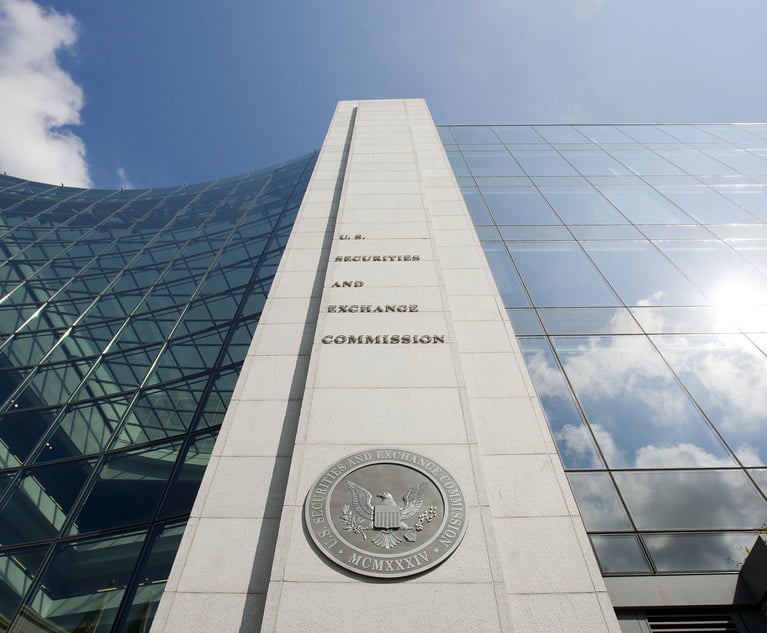A transparent attempt… to be efficient
Lack of transparency has always been seen as a negotiating advantage. There are signs, however, that this mindset is changing.
February 23, 2014 at 07:00 PM
4 minute read
You don't often hear the words “transparency” and “patents” in the same sentence. The conventional wisdom has long held that, for patent licensors, the less anyone knows about your patents, the better. Lack of transparency has always been seen as a negotiating advantage. There are signs, however, that this mindset is changing.
Last spring, for example, Microsoft General Counsel Brad Smith publicly called for open disclosure of the real party of interest in patent ownership, and soon after, Microsoft led by example, publishing online a freely available list of its 40,000-plus patents, all searchable by title, number, country and name of the entity to which the patent has been assigned. In December, Intellectual Ventures (IV) made a similar move, releasing a searchable list of 33,000 patents (or more than 80 percent of its holdings), a shift from its earlier position that its patent holdings were confidential information.
This is a significant and welcome change in attitude by two leading licensors. Whether or not the shift at IV was driven by public policy, it does represent economic common sense. The fact is that lack of transparency isn't a useful negotiating advantage for licensors and, as Microsoft recognized, transparency can actually facilitate licensing.
This is especially true for negotiations between patent holders and larger, more sophisticated companies. When I was running global IP at Cisco, would-be licensors often claimed they had a “large pile” of patents that they claimed we also infringed (supposedly worth tens or hundreds millions of dollars in license fees), but they disclosed specifics about as few of those patents as possible. In response, we always insisted on the identification of the actual patents we were being asked to license and justification for the payment demands.
Cisco, of course, had the expertise to run its own prior art searches and analyze patent claims to determine the strength of those patents. If a potential licensor kept its patents hidden, we had the resources to insist on seeing specific patents and/or ferret them out on our own. It could be expensive in the short term, but over the long run it helped us avoid unnecessary licenses and unreasonable terms.
For smaller companies, of course, it's harder to fight back and/or deal with a licensor who won't readily disclose. So while lack of transparency can be a negotiating advantage here, it generally doesn't make a lot of economic sense to exploit it, as smaller companies, by definition, represent smaller license revenues.
It appears that some larger patent owners and licensing entities may be starting to recognize this. Patent owners are often reluctant to disclose not only specific patent holdings but also the true owners behind the assets. Obviously, knowing both would help a potential licensee decide whether it needs to take a license to the portfolio and, perhaps just as importantly, what amount to pay (and how to negotiate and/or litigate). This is a good starting point, but beyond these basic attributes, it is beginning to be possible to itemize other patent valuation attributes—everything from detailing prior art to disclosing existing license terms to reporting any previous costs of litigating the patent in question and/or comparable assets.
This data has historically been almost impossible to ascertain. In recent years, RPX has gleaned data from operating company licensees to build an increasingly broad database of patent litigation and license transactions. This, coupled with greater transparency from patent owners, could greatly streamline the current patent licensing process by moving it out of the courtroom and into the marketplace. It could also spur real steps toward ensuring patents more accurately reflect the value of the patented invention rather than the hold-up costs of litigation.
These are positive trends for all users of proprietary technology, especially smaller companies that are at a disadvantage in licensing negotiations and litigation. It's our collective responsibility to maintain this progress toward greater transactional fairness and efficiency.
This content has been archived. It is available through our partners, LexisNexis® and Bloomberg Law.
To view this content, please continue to their sites.
Not a Lexis Subscriber?
Subscribe Now
Not a Bloomberg Law Subscriber?
Subscribe Now
NOT FOR REPRINT
© 2025 ALM Global, LLC, All Rights Reserved. Request academic re-use from www.copyright.com. All other uses, submit a request to [email protected]. For more information visit Asset & Logo Licensing.
You Might Like
View All
Antitrust in Trump 2.0: Expect Gap Filling from State Attorneys General
6 minute read

From Reluctant Lawyer to Legal Trailblazer: Agiloft's GC on Redefining In-House Counsel With Innovation and Tech
7 minute read
Ad Agency Legal Chief Scores $12M Golden Parachute in $13B Sale to Rival
3 minute readTrending Stories
- 1‘The Decision Will Help Others’: NJ Supreme Court Reverses Appellate Div. in OPRA Claim Over Body-Worn Camera Footage
- 2MoFo Associate Sees a Familiar Face During Her First Appellate Argument: Justice Breyer
- 3Antitrust in Trump 2.0: Expect Gap Filling from State Attorneys General
- 4People in the News—Jan. 22, 2025—Knox McLaughlin, Saxton & Stump
- 5How I Made Office Managing Partner: 'Be Open to Opportunities, Ready to Seize Them When They Arise,' Says Lara Shortz of Michelman & Robinson
Who Got The Work
J. Brugh Lower of Gibbons has entered an appearance for industrial equipment supplier Devco Corporation in a pending trademark infringement lawsuit. The suit, accusing the defendant of selling knock-off Graco products, was filed Dec. 18 in New Jersey District Court by Rivkin Radler on behalf of Graco Inc. and Graco Minnesota. The case, assigned to U.S. District Judge Zahid N. Quraishi, is 3:24-cv-11294, Graco Inc. et al v. Devco Corporation.
Who Got The Work
Rebecca Maller-Stein and Kent A. Yalowitz of Arnold & Porter Kaye Scholer have entered their appearances for Hanaco Venture Capital and its executives, Lior Prosor and David Frankel, in a pending securities lawsuit. The action, filed on Dec. 24 in New York Southern District Court by Zell, Aron & Co. on behalf of Goldeneye Advisors, accuses the defendants of negligently and fraudulently managing the plaintiff's $1 million investment. The case, assigned to U.S. District Judge Vernon S. Broderick, is 1:24-cv-09918, Goldeneye Advisors, LLC v. Hanaco Venture Capital, Ltd. et al.
Who Got The Work
Attorneys from A&O Shearman has stepped in as defense counsel for Toronto-Dominion Bank and other defendants in a pending securities class action. The suit, filed Dec. 11 in New York Southern District Court by Bleichmar Fonti & Auld, accuses the defendants of concealing the bank's 'pervasive' deficiencies in regards to its compliance with the Bank Secrecy Act and the quality of its anti-money laundering controls. The case, assigned to U.S. District Judge Arun Subramanian, is 1:24-cv-09445, Gonzalez v. The Toronto-Dominion Bank et al.
Who Got The Work
Crown Castle International, a Pennsylvania company providing shared communications infrastructure, has turned to Luke D. Wolf of Gordon Rees Scully Mansukhani to fend off a pending breach-of-contract lawsuit. The court action, filed Nov. 25 in Michigan Eastern District Court by Hooper Hathaway PC on behalf of The Town Residences LLC, accuses Crown Castle of failing to transfer approximately $30,000 in utility payments from T-Mobile in breach of a roof-top lease and assignment agreement. The case, assigned to U.S. District Judge Susan K. Declercq, is 2:24-cv-13131, The Town Residences LLC v. T-Mobile US, Inc. et al.
Who Got The Work
Wilfred P. Coronato and Daniel M. Schwartz of McCarter & English have stepped in as defense counsel to Electrolux Home Products Inc. in a pending product liability lawsuit. The court action, filed Nov. 26 in New York Eastern District Court by Poulos Lopiccolo PC and Nagel Rice LLP on behalf of David Stern, alleges that the defendant's refrigerators’ drawers and shelving repeatedly break and fall apart within months after purchase. The case, assigned to U.S. District Judge Joan M. Azrack, is 2:24-cv-08204, Stern v. Electrolux Home Products, Inc.
Featured Firms
Law Offices of Gary Martin Hays & Associates, P.C.
(470) 294-1674
Law Offices of Mark E. Salomone
(857) 444-6468
Smith & Hassler
(713) 739-1250






